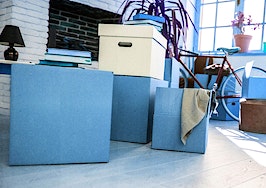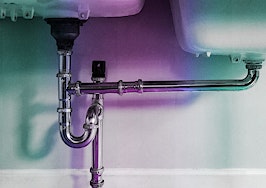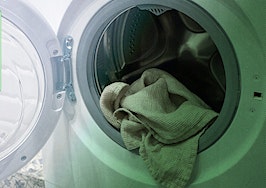 We want to help you make more money — right now. All month, go Back to Basics with Inman as real estate pros share what’s working now and how they’re setting up to profit in a post-pandemic world. Get full access to the series for 50 percent off here.
We want to help you make more money — right now. All month, go Back to Basics with Inman as real estate pros share what’s working now and how they’re setting up to profit in a post-pandemic world. Get full access to the series for 50 percent off here.
Most single-family homes are constructed and sold with plumbing supply lines for washing machines as well as heavy-duty electrical outlets to accommodate their installation. While most washing machines are compatible with a 120-volt power line, some homebuilders include 240-volt power lines for larger washing machines, some stoves and all dryers.
Laundry machines, originally the privilege of the wealthy, originated in the kitchen to be near the water supply. Over time, laundries were found in basements with floor drains to prevent flooding and damage to the construction of the house.
In today’s modern times, laundries are often located near bedrooms and bathrooms, where the majority of laundry originates. It’s far more efficient to undress, use towels in a bathroom and then load a washing machine with used garments and linens.
It’s also easier to remove clean clothing and towels, and return them to bedrooms and bathrooms where they are used when the laundry is in proximity to these spaces. Drains and waterproof floors under laundry machines will prevent leaks or floods in the event of an overflow or faulty supply hoses.
Washing machines come in multiple sizes and models — energy-efficient models, smaller European models and even combination units that will both wash and dry clothes in the same machine. Each laundry unit has pros and cons, and of course, each one has space and installation requirements.
Side-by-side washers and dryers are standard in most houses, while stacking units are space-efficient for apartments. Since dryers are lighter than washers, they’re often stacked on top of washers. If the washer and dryer is not a one-piece unit, a separate dryer may be hung on brackets from the wall above the dryer.
Washing machines require a water supply in the form of hoses from a cold-water supply line and a hot-water supply line. The supply hoses are rubber and should be inspected regularly for wear and cracks to prevent leaks.
It’s always a good idea to have new hoses installed with each new washing machine installation — as a precaution against flooding. Water that enters a washing machine (after it’s mixed with detergent and cleans dirty garments), must also be removed from the machine after use.
A drain for the machine’s used water enters a standpipe, which must be next to the washing machine. A standpipe is a vertical piece of pipe, a standard size of 36 inches, with a bend or “elbow” at the bottom. The elbow remains filled with water to prevent sewer gas from entering the laundry room.
Backflow is the term for water that flows back into the machine from the drain. Properly maintaining the standpipe and keeping it free of debris will prevent backflow. Water draining from a washing machine will have particles of dirt and lint, and may clog over time. A plumber’s auger or “snake” will clean out the drainpipe and keep the machine running smoothly.
Adding washing machines to apartments or houses without a designated laundry area
Prewar apartment buildings, in most cases, forbid washing machines in apartments, as older pipes can’t handle the flow of water required to fill and drain a washing machine.
If a tenant or shareholder installs a washing machine without permission, when the machine empties, sudsy water will appear in drains in the building — which is a dead giveaway that someone has illegally installed a laundry.
“Wet over dry” issues are another reason apartment buildings outlaw washing machines. If an apartment has two bathrooms, one may be converted to a laundry (with permission) to prevent excess water usage and backflow.
A licensed master plumber can adapt the hot and cold supply lines of either a shower or tub for use in the washing machine, and the tub or shower’s drain can be adapted with a standpipe for refuse water.
Washing machines should also be installed firmly in place and leveled with adjustable legs to prevent movement during the spin cycle. The tub or main body of the washing machine has shock absorbers or struts surrounding it to prevent excess movement.
The front and rear panels of the machine may have to be removed by a service technician if the washer is making too much noise or experiencing too much vibration.
American laundry machines are larger than European models. Smaller models will handle smaller loads, and use less water and different types of detergent. Washers labeled “HE,” which stands for “high efficiency,” produce lower levels of suds and have longer wash cycles.
Owners of these machines are, at first, often impatient with the longer cycles. The smaller machines are not conducive to larger loads such as comforters or blankets, often requiring a trip to the laundromat.
Many landlords will not allow washing machines under any circumstances due to concerns about leaks, noise and maintenance. Should a tenant opt to bring their own small apartment-sized washer into a rental, it is best to get permission and make the landlord aware. Tenants will pay for the electricity to run a washer, but the landlord will be paying for the water.
Washing machines in houses are typically a standard commodity. In apartments, they add convenience, but they can also bring hazards and problems. Most apartment buildings offer basement laundries where it’s extremely efficient to wash and dry several loads at once, making laundry day very efficient and hazard-free.
Gerard Splendore is a licensed associate real estate broker with Warburg Realty in New York. Connect with him on LinkedIn.









